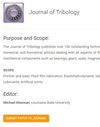Comparison of tribological characteristics of LM13/B4C and LM13/ilmenite composites at high temperature conditions
IF 3
3区 工程技术
Q2 ENGINEERING, MECHANICAL
引用次数: 0
Abstract
Abstract In this work, high temperature tribological characteristics of ilmenite reinforced LM13 aluminium alloy based composites (AMCs) and boron carbide reinforced AMCs are compared. Stir-cast composites were processed using boron carbide (CDP) and ilmenite (NDP) particles separately as reinforcements. Particle size range was 106–125 μm and reinforcement levels were 5, 10, and 15 wt.% for both types of composites. Both composites exhibited uniform distribution of reinforced particles and grain refinement. Compared to the LM13 base alloy, NDP composite containing 15 wt.% reinforcement showed significant improvement in hardness (57%), coefficient of friction (57%), mild-to-severe wear transition temperature, average steady-state wear rate (49%), and coefficient of thermal expansion (55%). CDP-15 composite showed slightly better properties than NDP-15 composite. Microstructure refinement, increased dimensional stability, formation of oxide layer, and formation of tribo-layer due to reinforcement of the ceramic fillers were the main reasons for improvement in properties of processed AMCs. SEM-EDS of wear tracks-debris showed abrasive/delamination wear as the main mechanisms for materials loss. The research showed that the low-cost ilmenite particles can substitute for the very costly boron carbide particles as reinforcements in AMCs used for dry sliding wear applications under high operating temperatures-applied load conditions of the order of 300°C-49 N.高温条件下LM13/B4C与LM13/钛铁矿复合材料摩擦学特性比较
本文比较了钛铁矿增强LM13铝合金基复合材料(AMCs)和碳化硼增强AMCs的高温摩擦学特性。分别以碳化硼(CDP)和钛铁矿(NDP)为增强剂制备了搅拌铸造复合材料。两种复合材料的粒径范围为106 ~ 125 μm,增强率分别为5%、10%和15% wt.%。两种复合材料均表现出增强颗粒分布均匀、晶粒细化的特点。与LM13基合金相比,含有15wt .%增强率的NDP复合材料在硬度(57%)、摩擦系数(57%)、中至重度磨损转变温度、平均稳态磨损率(49%)和热膨胀系数(55%)方面均有显著提高。CDP-15复合材料的性能略优于NDP-15复合材料。微观结构的细化、尺寸稳定性的提高、氧化层的形成和摩擦层的形成是陶瓷填料增强的主要原因。磨损轨迹-碎屑的SEM-EDS显示磨粒/脱层磨损是材料损失的主要机制。研究表明,在300°C-49 N的高温载荷条件下,低成本的钛铁矿颗粒可以替代昂贵的碳化硼颗粒作为干滑动磨损材料的增强材料。
本文章由计算机程序翻译,如有差异,请以英文原文为准。
求助全文
约1分钟内获得全文
求助全文
来源期刊
CiteScore
4.20
自引率
12.00%
发文量
117
审稿时长
4.1 months
期刊介绍:
The Journal of Tribology publishes over 100 outstanding technical articles of permanent interest to the tribology community annually and attracts articles by tribologists from around the world. The journal features a mix of experimental, numerical, and theoretical articles dealing with all aspects of the field. In addition to being of interest to engineers and other scientists doing research in the field, the Journal is also of great importance to engineers who design or use mechanical components such as bearings, gears, seals, magnetic recording heads and disks, or prosthetic joints, or who are involved with manufacturing processes.
Scope: Friction and wear; Fluid film lubrication; Elastohydrodynamic lubrication; Surface properties and characterization; Contact mechanics; Magnetic recordings; Tribological systems; Seals; Bearing design and technology; Gears; Metalworking; Lubricants; Artificial joints

 求助内容:
求助内容: 应助结果提醒方式:
应助结果提醒方式:


